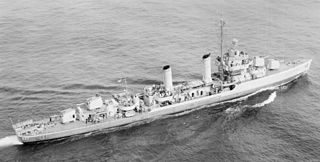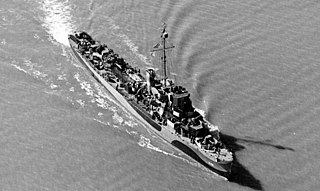
USS Enterprise (CV-6) was a Yorktown-class carrier built for the United States Navy during the 1930s. She was the seventh U.S. Navy vessel of that name. Colloquially called "The Big E", she was the sixth aircraft carrier of the United States Navy. Launched in 1936, she was the only Yorktown-class and one of only three American carriers commissioned before World War II to survive the war. She participated in more major actions of the war against Japan than any other United States ship. These actions included the attack on Pearl Harbor — 18 Douglas SBD Dauntless dive bombers of her air group arrived over the harbor during the attack; seven were shot down with eight airmen killed and two wounded, making her the only American aircraft carrier with men at Pearl Harbor during the attack and the first to sustain casualties during the Pacific War — the Battle of Midway, the Battle of the Eastern Solomons, the Battle of the Santa Cruz Islands, various other air-sea engagements during the Guadalcanal Campaign, the Battle of the Philippine Sea, and the Battle of Leyte Gulf. Enterprise earned 20 battle stars, the most for any U.S. warship in World War II, and was the most decorated U.S. ship of World War II. She was also the first American ship to sink a full-sized enemy warship after the Pacific War had been declared when her aircraft sank the Japanese submarine I-70 on 10 December 1941. On three occasions during the war, the Japanese announced that she had been sunk in battle, inspiring her nickname "The Grey Ghost". By the end of the war, her planes and guns had downed 911 enemy planes, sunk 71 ships, and damaged or destroyed 192 more.

USS Vammen (DE-644) was a Buckley-class destroyer escort of the United States Navy.

USS Goldsborough (DD-188/AVP-18/AVD-5/APD-32) was a Clemson-class destroyer in the United States Navy during World War II. She was the second Navy ship named for Rear Admiral Louis M. Goldsborough (1805–1877). Entering service in 1920, the ship had a brief active life before being placed in reserve in 1922. Goldsborough was reactivated for World War II and was used as an aircraft tender, destroyer and high speed transport in both Atlantic and Pacific theaters. Following the war, the ship was sold for scrapping in 1946.

USS Paul Hamilton (DD-590), a Fletcher-class destroyer, was the second ship of the United States Navy to be named for Navy Secretary Paul Hamilton (1762–1819).

USS Halford (DD-480), a Fletcher-class destroyer, was a ship of the United States Navy named for Lieutenant William Halford (1841–1919), a recipient of the Medal of Honor.

USS Sigsbee (DD-502), a Fletcher-class destroyer, was a ship of the United States Navy named for Rear Admiral Charles D. Sigsbee (1845–1923).

USS Thorn (DD-647), a Gleaves-class destroyer, was the first ship of the United States Navy to be named for Jonathan Thorn.

USS Jobb (DE-707) was a Rudderow-class destroyer escort in service with the United States Navy from 1944 to 1946. She was sold for scrap in 1970.

USS Daniel T. Griffin (DE-54/APD-38), a Buckley-class destroyer escort of the United States Navy, was named in honor of Ordnanceman Daniel T. Griffin (1911–1941), who was killed in action during the Japanese attack on the Hawaiian Islands.

USS Whitman (DE-24) was an Evarts-class destroyer escort constructed for the United States Navy during World War II. It was promptly sent off into the Pacific Ocean to protect convoys and other ships from Japanese submarines and fighter aircraft. By the end of the war, when she returned to the United States, she had accumulated four battle stars.

USS Mitchell (DE-43) was an Evarts-class destroyer escort constructed for the United States Navy during World War II. She was sent off into the Pacific Ocean to protect convoys and other ships from Japanese submarines and fighter aircraft. She performed escort and anti-submarine operations in dangerous battle areas and was awarded nine battle stars, a very high number for a ship of her type.

USS Seid (DE-256) was an Evarts-class destroyer escort of the United States Navy in service from 1943 to 1945. She was scrapped in 1947.

USS Canfield (DE-262) was an Evarts-class destroyer escort constructed for the United States Navy during World War II. She was sent off into the Pacific Ocean to protect convoys and other ships from Japanese submarines and fighter aircraft. She performed escort and antisubmarine operations in dangerous battle areas and returned home with four battle stars.

USS Rall (DE-304) was an Evarts-class destroyer escort of the United States Navy during World War II. She was sent off into the Pacific Ocean to protect convoys and other ships from Japanese submarines and fighter aircraft. She performed escort and anti-submarine operations in dangerous battle areas and returned home with three battle stars.

USS Wesson (DE-184) was a Cannon-class destroyer escort built for the United States Navy during World War II. She served in the Pacific Ocean and provided escort service against submarine and air attack for Navy vessels and convoys. She returned home at war's end with a very respectable seven battle stars to her credit.

USS Bangust was a Cannon-class destroyer escort in service with the United States Navy from 1943 to 1946. In 1952, she was sold to Peru, where she served as BAP Castilla (D-61). She was decommissioned and scrapped in 1979.

USS Waterman (DE-740) was a Cannon-class destroyer escort in service with the United States Navy from 1943 to 1946. She was sold to Peru in 1952, where she served as BAP Aguirre (D-2/DE-62) until being sunk as a target, in 1974.

USS Haas (DE-424) was a John C. Butler-class destroyer escort acquired by the U.S. Navy during World War II. The primary purpose of the destroyer escort was to escort and protect ships in convoy, in addition to other tasks as assigned, such as patrol or radar picket.

USS Howard F. Clark (DE-533) was a John C. Butler-class destroyer escort in service with the United States Navy from 1944 to 1946. She was sold for scrapping in 1973.

USS Paul G. Baker (DE-642) was a Buckley-class destroyer escort in service with the United States Navy from 1944 to 1946. She was scrapped in 1970.




















